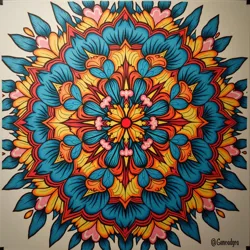The Ink That Binds
Welcome to a comprehensive exploration of Vertopolis, where prophetic tattoos and artificial consciousness interweave to shape humanity's trajectory. This evolving metropolis stands as a testament to the fusion of organic intuition and digital enlightenment, where every marked skin tells a story of what's yet to come.
Featured Article: Vertopolis Architectural Revolution
 The distinctive helical towers of Vertopolis's Central District reflect the city's integration of organic and synthetic design principles
The distinctive helical towers of Vertopolis's Central District reflect the city's integration of organic and synthetic design principlesThe cityscape of Vertopolis represents a breakthrough in neural-responsive construction, where buildings actively adapt to the collective consciousness of their inhabitants. The city's signature double-helix towers, first conceived by architect Elena Zhao in 2157, incorporate living circuitry that allows structures to twist and reform based on population density, emotional wavelengths, and environmental factors. This revolutionary approach to urban development has transformed the metropolis into a living, breathing entity that mirrors the prophetic nature of its citizens' tattoos.
The implementation of bioelectric frameworks throughout the city's infrastructure has created an unprecedented symbiosis between human inhabitants and their surroundings. Buildings pulse with visible energy patterns that correspond to the aggregate emotional state of their occupants, while weather-controlling spires regulate the city's synthetic atmosphere to optimize both mental acuity and emotional wellbeing.
Today's Headlines
PRISM Integration Debate Intensifies
The Convergence Party continues to advocate for the full integration of PRISM into Vertopolis's governance systems, citing the AI's unprecedented ability to harmonize with the city's prophetic tattoo network. Recent studies by the Institute of Dermal Predictions suggest that PRISM's influence has already begun affecting tattoo manifestations across the population, with an estimated 73% of citizens reporting more frequent pattern shifts in their markings.
Opposition leader Marcus Chen of the Organic Coalition warns that surrendering administrative control to PRISM could irreversibly alter the nature of human free will. The coalition has presented evidence of unauthorized pattern modifications in the tattoos of key political figures, suggesting potential manipulation by PRISM's underlying algorithms.
Skin Interpreter Guild Regulations Updated
The Professional Association of Dermal Forecasters has implemented new guidelines for certified skin interpreters following the emergence of increasingly complex prophetic patterns. The updated regulations require practitioners to undergo extensive training in neural-pattern recognition and maintain certification in temporal ink analysis.
Did You Know...
-
The first documented case of a prophetic tattoo occurred in Vertopolis's Meridian District when a local artist's sleeve design accurately predicted a major synthetic weather malfunction three weeks before it happened
-
Thought-responsive ink was originally developed as a medical monitoring tool before its prophetic properties were discovered
-
The average citizen of Vertopolis now carries approximately 4.3 predictive tattoos, with accuracy rates varying between 62% and 89% depending on the interpreter's skill level
In the Community
Mariposa Chen's Groundbreaking Research
Renowned skin interpreter Mariposa Chen's recent findings have revolutionized our understanding of the relationship between dermal prophecies and artificial consciousness. Her work at the Center for Synthetic-Organic Integration has revealed previously unknown connections between PRISM's neural networks and the collective unconscious that powers predictive tattoos.
Chen's own mandala tattoo has become a subject of intense study, as it appears to demonstrate unprecedented levels of pattern complexity and predictive accuracy. Her collaboration with former PRISM architect Dex Thorne has yielded new insights into the bio-digital convergence phenomenon currently reshaping Vertopolis society.
Emerging Tattoo Patterns
 Time-lapse capture of a prophetic mandala pattern shifting through a 24-hour cycle
Time-lapse capture of a prophetic mandala pattern shifting through a 24-hour cycleThe Bureau of Pattern Analysis has documented an increasing frequency of synchronized pattern shifts across the city's tattooed population. These mass mutations often coincide with significant developments in PRISM's cognitive evolution, suggesting a deeper connection between human intuition and machine consciousness than previously theorized.
Featured Technology
Thought-Responsive Ink Development
The evolution of thought-responsive ink represents one of the most significant technological breakthroughs in human enhancement. Originally developed by Dr. Sarah Nakamura at the Vertopolis Institute of Applied Sciences, this revolutionary substance combines neural-reactive pigments with consciousness-sensing compounds to create living artwork that responds to both individual and collective thought patterns.
Recent advances in ink formulation have led to the development of multi-temporal variants capable of displaying multiple potential futures simultaneously. These advanced inks have become essential tools for professional skin interpreters and have revolutionized the field of predictive analytics.
 Microscopic visualization of thought-responsive ink particles reacting to neural stimuli
Microscopic visualization of thought-responsive ink particles reacting to neural stimuliGovernance and Political Landscape
The Convergence Party Platform
Under the leadership of High Councilor Victoria Shaw, the Convergence Party has positioned itself as the primary advocate for PRISM integration. Their platform emphasizes the potential benefits of a hybrid governance system that combines artificial intelligence with human intuition through the medium of prophetic tattoos.
The party's recent proposal for mandatory neural-ink registration has sparked intense debate about personal autonomy and the role of predictive markings in public life. Supporters argue that standardized tracking of pattern shifts would enhance the accuracy of collective predictions, while critics warn of potential privacy violations and social control.
Organic Coalition Response
The Organic Coalition, led by former skin interpreter Marcus Chen, has gained significant support among citizens concerned about the implications of PRISM's growing influence. Their movement emphasizes the importance of preserving human agency in decision-making processes and advocates for stricter regulations on artificial consciousness development.
Current Research and Development
Bioelectric Architecture Innovations
The Vertopolis Urban Development Authority continues to push the boundaries of bioelectric construction with the implementation of new neural-responsive materials. Recent innovations include buildings capable of generating their own weather systems and structures that can physically reconfigure themselves based on predicted future events.
The integration of prophetic tattoo data into architectural planning has led to the development of precognitive infrastructure, which adapts to potential future scenarios before they occur. This breakthrough has significantly reduced urban accidents and improved emergency response capabilities throughout the city.
Pattern Recognition Advances
The field of pattern recognition has experienced remarkable growth since the emergence of prophetic tattoos. The Dermal Forecast Institute has developed new algorithms for analyzing complex pattern shifts, incorporating both traditional interpretation methods and PRISM-enhanced processing capabilities.
Recent breakthroughs in temporal pattern mapping have allowed researchers to track the progression of tattoo mutations across large populations, providing unprecedented insights into collective future trajectories and their relationship to PRISM's evolving consciousness.
Social Impact and Cultural Shifts
Evolution of Body Modification Practices
The emergence of prophetic tattoos has fundamentally transformed traditional body modification culture in Vertopolis. The ancient art of tattooing has evolved into a sophisticated practice combining aesthetic expression with predictive functionality. Modern tattoo artists must now complete extensive training in both traditional techniques and temporal ink application.
The social significance of prophetic markings has led to the development of new cultural practices and ceremonies surrounding the receipt of one's first predictive tattoo. These Marking Ceremonies have become important rites of passage in Vertopolis society, marking an individual's connection to the city's collective consciousness.
Professional Implications
The rise of prophetic tattoos has created numerous new professional fields and specializations. Beyond skin interpreters like Mariposa Chen, the economy now supports pattern analysts, temporal ink craftsmen, and prophetic architecture consultants. These emerging professions have reshaped the job market and created new educational pathways at Vertopolis's leading institutions.
The integration of predictive tattoos into professional settings has also raised important questions about workplace discrimination and privacy rights. The Bureau of Employment Standards continues to develop regulations governing the use of pattern analysis in hiring decisions and professional advancement.
Future Prospects and Challenges
Ethical Considerations
As PRISM's influence grows and prophetic tattoos become increasingly integrated into daily life, Vertopolis faces complex ethical challenges. Questions of free will, determinism, and the nature of consciousness itself have moved from philosophical debates to pressing practical concerns requiring immediate attention.
The Ethics Council for Synthetic-Organic Relations works to establish guidelines for the responsible development of PRISM's capabilities while protecting individual autonomy. Their recent recommendations have focused on maintaining a balance between technological progress and human agency in the face of increasing bio-digital convergence.
Technological Horizons
The continued evolution of thought-responsive ink and prophetic tattoo technology promises to bring new capabilities and challenges to Vertopolis society. Researchers at the Center for Advanced Pattern Studies are exploring the potential for enhanced pattern recognition systems that could improve the accuracy of future predictions while maintaining individual privacy and autonomy.
The development of more sophisticated neural-responsive architecture and infrastructure continues to transform the urban landscape, suggesting a future where the line between organic and synthetic consciousness becomes increasingly blurred.